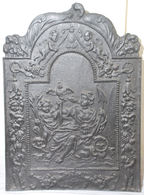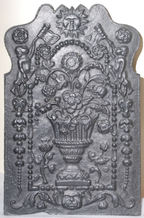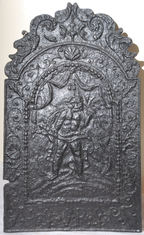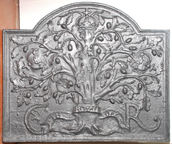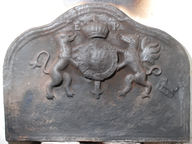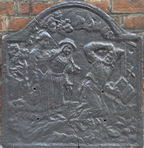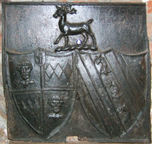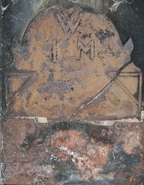-
674
Description: Arched rectangular shaped central panel with bead edging; pictorial scene of a seated female figure resting against a hurdle, holding an anchor, a child on each side of her, the one on the left standing clutching corn stalks, the one on the right sitting also holding the anchor and a circular object; a bird sits on a post; arched rectangular border with fillet edging; at the top of the arch a cartouche from which are suspended two ribbons, each held by a putto, from which cascade flowers and fruit, each lower part hung from a ring; two putti are on each side, one climbing on the suspended ribbon, the other at its foot; at the bottom, an empty cartouche between two clusters of flowers each suspended on a ribbon tied to a scroll; on top, two descending cornucopiae.
Notes: The figure represents Hope. The theft in 1699 from a Thames-side warehouse of several firebacks, including '3 of Hope with an Anchor' may refer to this type (Post Boy 11-14 Nov. 1699).
Copies of this fireback are known.
- Decoration tags:
- 'Dutch' (shape)
- fillet (edging)
- whole carved pattern
- pictorial
- allegorical
- humans
- objects
Manufactured: in the mid- to late-17th century in the Siegerland area of Germany.
Current location: Saffron Walden Museum, Saffron Walden, Essex, England.
Museum number: 1889-9 (part of the Saffron Walden Museum museum group)
- Attached to series:
- 'Dutch' HIS series
- Hope firebacks
-
675
Description: Quasi-arched rectangular shape; fillet edging; centre, fluted flower vase containing a variety of flowers, with a plant growing on each side, all within an arched rectangular bead-and-pellet border with looped top corners; on each side, a festoon of bell flowers, with a putto blowing a trumpet above; over each of their heads a single rose; top centre, a sunburst; bottom, an animal’s face between mirrored swirled foliage.
Notes: One of a small group of firebacks with similar outlines.
Copies of this fireback are known.
Manufactured: in the early- to mid-18th century in England.
Current location: Saffron Walden Museum, Saffron Walden, Essex, England.
Museum number: 1897-03 (part of the Saffron Walden Museum museum group)
- Attached to series:
- Late pictorial series (all)
- Late pictorial series 6
-
676
Description: Arched rectangular central panel; bead-and-pellet edging; scene showing a semi-naked figure holding a trident in his right hand and a sheaf of corn in his raised left hand; standing on ground, with swagged drapery and tassels above, and an anchor behind right; arched rectangular border with fillet edging; on top, scallop shell symmetrical descending arrangement of swirled fronds and shells, which continue on the bottom; monogram at bottom centre; on top, mirrored stylised sea monsters.
Notes: The figure is Neptune, one of a set of 'Eight Deities' engraved by Hendrick Goltzius (1592), after Polidoro da Caravaggio; the fireback is one of a large group bearing the same initials, which probably denotes the pattern maker. Other groups may have been the work of the same carver or workshop. The execution is rather crude.
Copies of this fireback are known.
Inscription: SHR
- Decoration tags:
- 'Dutch' (shape)
- fillet (edging)
- whole carved pattern
- pictorial
- mythological
- monogram
- text
- humans
Manufactured: in the late-17th to early-18th century in England.
Current location: Saffron Walden Museum, Saffron Walden, Essex, England.
Museum number: 1889-35 (part of the Saffron Walden Museum museum group)
- Attached to series:
- SHR series
- British 'Dutch' style firebacks
- Eight Deities series
-
678
Description: Arched rectangular main panel; fillet edging; nude female figure standing on shield and holding a wind-blown sheet, upon a ground; suspended floral garlands with swirled foliage above; on top, a scallop shell between two symmetrical sea serpents
Notes: The figure is of Fortune. The theft in 1699 from a Thames-side warehouse of several firebacks, including '5 iron Chimney-Backs cast in the figure of Fortune standing naked on a Conchus in the Sea' may refer to this type (Post Boy 11-14 Nov. 1699).
- Decoration tags:
- 'Dutch' (shape)
- fillet (edging)
- whole carved pattern
- pictorial
- allegorical
- humans
Manufactured: in the mid- to late-17th century possibly in the Siegerland area of Germany.
Current location: Saffron Walden Museum, Saffron Walden, Essex, England.
Museum number: 1901-39 (part of the Saffron Walden Museum museum group)
- Attached to series:
- 'Dutch' Miscellaneous Firebacks
-
679
Description: Arched rectangular shape; cavetto moulding all round; spreading oak tree, with leaves and acorns, filling the whole plate; three royal crowns, one at the top of the tree, the other two symmetrically on the ends of branches towards the top corners; initials CR towards the bottom corners, the remaining inscription on a scroll across the base.
Notes: The design is derived from the celebrated occasion when Charles II evaded his pursuers by hiding in an oak tree at Boscobel House, near Wolverhampton, following the final Royalist defeat at the battle of Worcester in 1651. This popular fireback has been copied frequently.
Copies of this fireback are known.
Inscription: C THE ROYALL OAK R
- Decoration tags:
- rectangular with round arch (shape)
- cavetto (edging)
- whole carved pattern
- heraldic
- pictorial
- historical
- text
- plants
Manufactured: in the mid-17th century in England.
Current location: Saffron Walden Museum, Saffron Walden, Essex, England.
Museum number: 1899-2 (part of the Saffron Walden Museum museum group)
Citation: Butterfield, W. R., 19 Jan 1935, 'Charles II Fireback', Hastings and St Leonards Observer.
Citation: Butterfield, W. R., 1916, 'Old Wealden Firebacks', The Connoisseur, 46, pp. 197-209.
- Attached to series:
- Commemorative firebacks
-
806
Description: Rectangle with curved shoulders and low arch joined with concave curves; fillet and ogee moulded edging; central Tudor royal shield surrounded by garter, with crown above and lion and dragon supporters; royal initials either side of crown; lower right, inclined rectangular stamp of a dog; extended variant.
Notes: On clearer examples the garter motto has ‘EQVI’ instead of ‘HONI’, making it meaningless; possibly ‘EQVI’ was a mis-transcription of ‘HONI’; the crown is distinctly continental in form; a much-copied fireback.
Copies of this fireback are known.
Inscription: E R [Garter motto illegible]
Arms: Tudor royal - Elizabeth I
- Decoration tags:
- rectangular with round arch (shape)
- fillet and ogee (edging)
- carved stamps
- individual letters
- armorial
- royal
- text
- animals
Manufactured: in the mid- to late-16th century possibly in the Forest of Dean area of England.
Current location: in private hands, Salfords, Surrey, England.
-
1044
Description: Arched rectangular shape with sloped spandrels; stepped fillet-moulded edging; pictorial scene of a behatted woman and a girl standing behind a kneeling cloaked figure of a man wearing a pointed cap and holding an open book, with a cross above it; to the left a cottage with trees and ground; to the right the frame of a building.
Notes: The scene is entitled 'Frère Luce', copied from an engraving by Nicolas Larmessin III (1656-1725), of a painting (now lost) by Nicolas Vleughels (1668-1737), from 'Suites d'Estampes Nouvelles pour les Contes de La Fontaine' (c.1736-43).
Copies of this fireback are known.
- Decoration tags:
- rectangular with round arch (shape)
- stepped fillet (edging)
- whole carved pattern
- pictorial
- humans
- plants
- objects
Manufactured: in the mid- to late-18th century in France.
Current location: in private hands, not known.
Citation: Carpentier, H., 1912, Plaques de Cheminées (Paris, published by the author).
- Attached to series:
- Miscellaneous pattern firebacks
-
1099
Description: Rectangular shape; ovolo-moulded edging; raised central rectangular panel with inset stylised design of a rounded arch upon Ionic columns, the inside edge indented; at quarter angles outside the arch, two trefoils; within the arch, sequence of linked hollow strapwork rhomboids and circles; between the columns, a roundel with the internal edge indented; left of the central panel, 16 above upper-case M in low relief; right of the central panel, 56 above upper-case G in low relief.
Notes: An unusually small but well-preserved back with a stylised design. The style of the numerals, particularly the 6 and 5, can be seen on a larger fireback of 1653.
Copies of this fireback are known.
Inscription: 16 56 / M G
- Decoration tags:
- rectangular (shape)
- ovolo (edging)
- carved stamps
- whole carved pattern
- individual letters
- individual numbers
- architectural
- text
Manufactured: in 1656 in the Weald area of England.
Current location: Avery Way, Tamar View Industrial Estate, Saltash, Cornwall, England.
- Attached to series:
- Date & initials firebacks
- 1650s Wealden series
-
1031
Description: Rectangular; astragal and fillet edging; two heater-shaped shields side by side, with a stag trippant crest above centre.
Notes: The dexter shield: quarterly first and fourth - Mostyn baronet - Gules a saracen's head erased proper wreathed about the temples sable and argent; second and third, within a bordure a fess fusily (or three lozenges in fess); a baronet's inescutcheon in the centre chief. The sinister shield - Sale - Argent on a bend cotised three gryphons' heads erased. Crest (Mostyn), a stag trippant proper.
Arms: Left: Mostyn with unknown quartering; right: Sal, Sale, Salle or Salley
- Decoration tags:
- rectangular (shape)
- astragal & fillet (edging)
- carved stamps
- heraldic
- armorial
- animals
- humans
Manufactured: in the 19th century in England.
Current location: in private hands, Saxtead, Suffolk, England.
- Attached to series:
- Personal armorial firebacks
-
1200
Description: Arched rectangular plain shape with the sides of the arch concave, and with a diamond-shaped protrusion on each side; astragal edged sides terminating at the shoulders of the platre with a triangle on each side; top centre, initials in triad.
Notes: As small and unusual fireback of which only the upper part is visible, the lower part concealed behind a metal plate.
Inscription: IWM [triad]
- Decoration tags:
- rectangular with round arch (shape)
- astragal (edging)
- individual letters
- text
Manufactured: in the 17th century possibly in the Weald area of England.
Current location: in private hands, Scaynes Hill, West Sussex, England.
- Attached to series:
- Initials only firebacks
